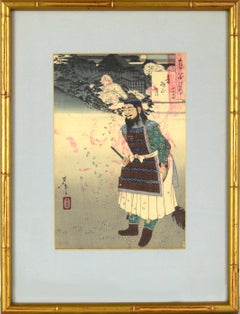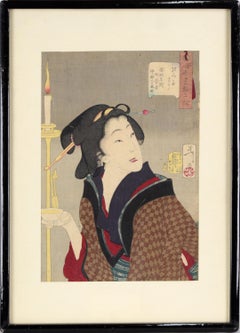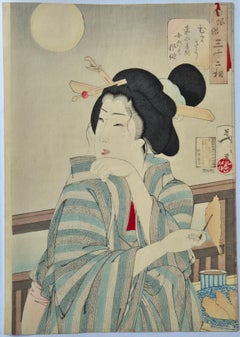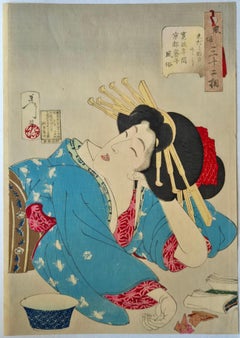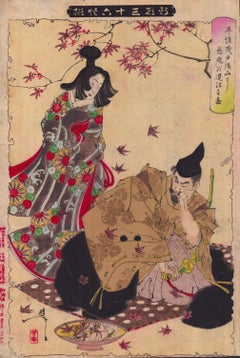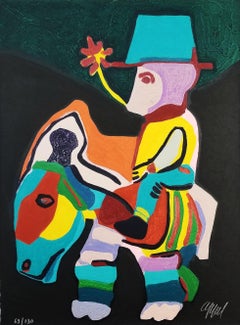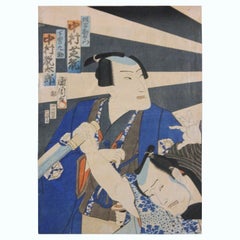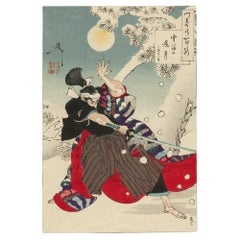Tsukioka Yoshitoshi Art
Japanese, 1839-1892
Born in Edo in 1839, Yoshitoshi became a student of noted woodblock artist Kuniyoshi in 1850, at the age of eleven. His first print, a triptych of a historical naval battle, was issued just three years later. After Kuniyoshi's death in 1861, Yoshitoshi earned his living designing prints of kabuki actors.
The 1860s were a time of increasing political unrest in Japan. A witness to the Battle of Ueno, a massacre of the shogun's supporters by imperial forces in 1868, Yoshitoshi's bloody battle prints during this period reflect the violence and upheaval of the time.
Yoshitoshi experienced some commercial success in the late 1860s, earning popularity designing prints for newspapers, but in 1871 he fell into a deep depression, living in poverty and unable to work. The year 1873 marked a rebirth for Yoshitoshi, as he emerged from his illness and began using a new go or artist name: Taiso, which means great resurrection. The following decades would see the production of his greatest work.
Considered his masterwork, Yoshitoshi's series One Hundred Aspects of the Moon was published from 1885-1892. These quiet and reflective prints, beautifully composed and drawn, feature subjects from traditional Japanese and Chinese history and legend, rendered with great sensitivity and emotion. Yoshitoshi's other important series from this period include New Forms of Thirty-six Ghosts and Thirty-two Aspects of Customs and Manners.
Sadly, Yoshitoshi's mental illness returned, and he was hospitalized in 1891. He continued to work intermittently, but died of a cerebral hemorrhage in 1892 at the age of fifty-three.
Yoshitoshi was the most influential woodblock print artist of Meiji era Japan. His prints shimmer with energy and bring to life the tales of ancient Japan: the downfall of the once mighty, untouchable beauty, military conquests, and slices of everyday life. A consummate draftsman and imaginative designer, Yoshitoshi brought creativity, emotion, and elegance to images that continue to resonate with audiences today.to
1
2
8
5
4
1
1
1
1
1
Period: Late 19th Century
One Hundred Aspects of the Moon, Mt Otawa Moon - Bright God Tamura
By Tsukioka Yoshitoshi
Located in Soquel, CA
"Mount Otawa Moon: Bright God Tamura" - Woodblock on Paper by Tsukioka Yoshitoshi
From the series "One Hundred Aspects of the Moon"
This piece depicts the general Sakanoe no Tamura...
Category
1880s Edo Tsukioka Yoshitoshi Art
Materials
Paper, Ink, Woodcut
"Thirsty: the appearance of a town geisha in the Ansei era" - Woodblock on Paper
By Tsukioka Yoshitoshi
Located in Soquel, CA
"Thirsty: the appearance of a town geisha in the Ansei era" - Woodblock on Paper
From the series "Thirty-two Aspects of Customs and Manners" (Fuzoku sanjuniso)
Lively woodblock of a...
Category
1880s Edo Tsukioka Yoshitoshi Art
Materials
Paper, Ink, Woodcut
Tsukioka Yoshitoshi -- Looking Tasty, the Appearance of a Prostitute during the
By Tsukioka Yoshitoshi
Located in BRUCE, ACT
Tsukioka Yoshitoshi
Looking Tasty, the Appearance of a Prostitute during the Kaei Era from Thirty-Two Daily Scenes (風俗三十二相), 1888
Woodblock print
Oban
This piece depicts a woman on...
Category
1880s Tsukioka Yoshitoshi Art
Materials
Woodcut
Tsukioka Yoshitoshi -- Looks Slovenly', Mannerisms of a Kyoto Geisha
By Tsukioka Yoshitoshi
Located in BRUCE, ACT
Tsukioka Yoshitoshi
Looks Slovenly', Mannerisms of a Kyoto Geisha from the Kansei Period from Thirty-Two Daily Scenes (風俗三十二相), 1888
Woodblock print
Oban
Category
1880s Tsukioka Yoshitoshi Art
Materials
Woodcut
Yoshitoshi: Taira no Koremochi Vanquishing the Demon of Mount Togakushi
By Tsukioka Yoshitoshi
Located in BRUCE, ACT
Tsukioka Yoshitoshi
Taira no Koremochi Vanquishing the Demon of Mount Togakushi
From Series: “New Forms of Thirty-six Ghosts”
「新形三十六怪撰」 「平惟茂戸隠山に悪鬼を退治す図」
C. 1890
Size: Oban
Ex...
Category
1890s Tsukioka Yoshitoshi Art
Materials
Woodcut
Related Items
L'Âne Trop Paisible Pour Les Enfants Cruels /// Karel Appel Color Woodcut COBRA
By Karel Appel
Located in Saint Augustine, FL
Artist: Karel Appel (Dutch, 1921-2006)
Title: "L'Âne Trop Paisible Pour Les Enfants Cruels (A Donkey Too Gentle for the Cruel Children)" (Plate 19)
Portfolio: Circus (Volume II)
*Si...
Category
1970s Abstract Expressionist Tsukioka Yoshitoshi Art
Materials
Engraving, Woodcut
Two Kabuki Actors Japanese Woodblock Print
By Toyohara Kunichika
Located in Houston, TX
Two kabuki actors posing a samurai's. The print is printed on rice paper and is not framed. It is stamped by the artist with details about the actors in ...
Category
1860s Edo Tsukioka Yoshitoshi Art
Materials
Woodcut
"Mine Shaft", Soviet Union: An Early 20th C. Woodcut Engraving by Abramovitz
By Albert Abramovitz
Located in Alamo, CA
This is a signed woodcut engraving entitled "Mine Shaft" created by Albert Abramovitz in 1935, after a trip to the Soviet Union. It depicts two Russian workers constructing a mine sh...
Category
1930s Tsukioka Yoshitoshi Art
Materials
Woodcut
The Moon Crossing Bridge at Arashiyama in Yamashiro Province, Original Woodblock
By Utagawa Hiroshige
Located in Saint Augustine, FL
Artist: Utagawa Hiroshige (1797-1858) Japanese
Title: The Moon Crossing Bridge at Arashiyama in Yamashiro Province
Medium: Original Woodblock Print
Year: 1853 - 1856
Dimensions: Framed 16" x 23", Unframed 8.5" x 13"
Hiroshige Utagawa grew up in a samurai family in Edo where both him and his father were in the fire service before being orphaned. Hiroshige’s first formal art teacher was Rinsai. Though Hiroshige tried to join Toyokuni Utagawa's studio, he was turned away. In 1811, young Hiroshige entered an apprenticeship with the celebrated Toyohiro Utagawa. After only a year, he was bestowed with the artist name Hiroshige. He gave up his role in the fire department to focus entirely on painting and print design. He studied painting, intrigued by the Shijo school. Hiroshige’s artistic genius wasn’t recognized until 1832 when he became a master of the ukiyo-e woodblock printing tradition, creating 8000 prints in saturated color.
His series of woodblock prints of the Tokaido road connecting Edo to Kyoto was his breakthrough series known as The 53 Stations of the Tokaido (1832-1833). His most renowned series was known as 100 Famous Views of Edo...
Category
Mid-19th Century Edo Tsukioka Yoshitoshi Art
Materials
Woodcut
Edo Landscape Japanese Woodblock Print
By Utagawa Hiroshige (Ando Hiroshige)
Located in Houston, TX
Edo Meisho woodblock print of a famous Japanese coastal dock. This woodblock is most likely apart of the series "One Hundred Famous Views of Edo." The woodblock print is printed on r...
Category
1850s Edo Tsukioka Yoshitoshi Art
Materials
Woodcut
H 10 in W 15 in D 0.004 in
'Musicians Viewing the Full Moon', Large Japanese Color Woodblock Print, Biwa
By Ogyu Tensen
Located in Santa Cruz, CA
Signed, lower right, with artist's chop mark in Hiragana, 'Tensen-e' 天泉絵, for Ogyū Tensen 荻生天泉 (Japanese, 1882-1947)
A large, early-20th-century, hand-colored Japanese woodblock showing elegantly-robed figures seated beside musical instruments in a panoramic landscape and viewing the full moon through golden clouds. An elegant example composed with clear artistic vision and printed with a consummate mastery of a challenging medium.
Nihonga style painter Ogyu Tensen was born in present-day Nihonmatsu City, Fukushima Prefecture. He studied at the Tokyo Fine Arts School, where he was taught by the well-known Kanō school painter Gahō Hashimoto (1835-1908), who was instrumental in the development of nihonga painting. Tensen was selected to participate in the first Bunten exhibition (Ministry of Education Fine Arts Exhibition) in 1907, in which he won an award. He went on to win many other awards at the Bunten exhibitions and the exhibitions of its successor organizations, the Teiten (Imperial Academy of Fine Arts) and Shin Bunten along with exhibitions of the Japan Arts Institute (Nihon Bijutsuin) and the post-war 1946 Nitten (Japan Fine Arts Exhibition). Along with his work in printmaking, the Imperial Court commissioned paintings by him.
Tensen was a member of the Futaba kai artist...
Category
1920s Tsukioka Yoshitoshi Art
Materials
Woodcut, Paper, Fiberboard
"Ciudad de un millón" contemporary neobarroque arquitecture city blue landscape
By Pedro Friedeberg
Located in Ciudad de México, MX
The repetition of patterns and rhythm is present in almost every piece of Pedro´s work.
The hybrid topographies that Pedro Friedeberg´s unclassifiable practice recreates we must rec...
Category
21st Century and Contemporary Contemporary Tsukioka Yoshitoshi Art
Materials
Digital, Paper, Ink, Screen
Wandering Monks in the Courtyard of Konoura - Woodcut by U. Hiroshige II - 1840s
By Utagawa Hiroshige II
Located in Roma, IT
Wandering monks in the courtyard of Konoura is an original modern artwork realized by Utagawa Hiroshige II (1826 – 1869) in the 1840s.
Good impression with reduced palette mainly in...
Category
1840s Modern Tsukioka Yoshitoshi Art
Materials
Paper, Woodcut
H 7.88 in W 11.82 in D 0.04 in
Zwei Frauen (Two Women) /// German Expressionism Karl Schmidt-Rottluff Woodcut
By Karl Schmidt-Rottluff
Located in Saint Augustine, FL
Artist: Karl Schmidt-Rottluff (German, 1884-1976)
Title: "Zwei Frauen (Two Women)"
Portfolio: Das Spiel Christa vom Schmerz der Schönheit des Weibes (The Play Christa from the Pain of the Beauty of the Woman)
*Issued unsigned
Year: 1918
Medium: Original Woodcut Engraving on wove paper
Limited edition: Unknown
Printer: Fritz Voigt, Berlin, Germany
Publisher: Verlag Die Aktion, Berlin, Germany
Reference: Schapire No. 222, page 45; Jentsch No. 35. Rifkind No. 2563; Lang No. 300; Reed No. 118
Overall size with attached page: 8.5" x 10.63"
Sheet size: 8.5" x 5.38"
Image size: 6.5" x 3.63"
Condition: Toning to sheet (as normal). A few tiny pinholes in right margin. In very good condition
Very rare
Notes:
Provenance: private collection - Oxnard, CA. Comes from a complete originally bound 48 page folio with 9 original woodcut engravings by Schmidt-Rottluff. Text by Alfred Brust. Presently attached to its accompanying page. The cover and title pages in pictures are not included, only for reference/provenance. There is an example of this work in the permanent collection of the Brücke Museum, Berlin, Germany.
Biography:
Karl Schmidt-Rottluff (born December 1, 1884, Rottluff, near Chemnitz, Germany—died August 9, 1976, West Berlin [now Berlin]), German painter and printmaker who was noted for his Expressionist landscapes and nudes.
In 1905 Schmidt-Rottluff began to study architecture in Dresden, Germany, where he and his friend Erich Heckel met Ernst Ludwig Kirchner and Fritz Bleyl...
Category
1910s Expressionist Tsukioka Yoshitoshi Art
Materials
Engraving, Woodcut
Modern American Industrial Landscape
Located in Buffalo, NY
An original woodblock print dated 1965, titled "Our Town" but signed illegibly.
Category
1960s American Modern Tsukioka Yoshitoshi Art
Materials
Paper, Woodcut
Beauties on the Beach with view of Mount Fuji
By Yoshu Chikanobu
Located in Burbank, CA
Shichirigahama, Sagami Province. A beauty in the foreground waves to her young companions, who run towards her on the beach. The beauty at left wears a western-style golden ring. We ...
Category
1890s Edo Tsukioka Yoshitoshi Art
Materials
Handmade Paper, Mulberry Paper, Woodcut
Art deco handcolored woodcut on paper - Walking black panther by Gaston Suisse
Located in Les Acacias GE, GE
Gaston Suisse (1896-1988)
Panthère noire dans les bambous, 1927
Gravure sur bois, sur papier Velin de Van Gelder.
Rehaussé aux lavis d’encre de Chine par l’artiste
Signé en bas à gauche et daté 1927 en bas à droite
Black panther in a forest of bamboos, 1927
A handcolored woodcut on Velin de Van Gelder paper
Signed and dated 1927
Bibliographie /Literature
Gaston Suisse, splendeur du laque art déco. Emmanuel Bréon. Somogy Éditions d'art, Paris 2013, reproduite page 105 (un autre exemplaire reproduit)
The artist made a wood engraving of which he made about twenty prints himself.
These proofs were not marketed as is, Gaston Suisse reworked each of the proofs using Indian ink washes in order to obtain different effects for each proof, which are thus unique original works.
Born in 1896 in a family of artists, his father Georges was a close friend of Siegfried Bing and a great lover of Japanese art and a bibliophile. He passed his taste for art to his son whom he often took to draw at the Botanic Garden . Around 1910, Gaston Suisse, who hasn't entered yet the artistic school, met Paul Jouve, then 18 years his elder, who was already famous.
In 1911, at the age of 17, he entered the National School of Decorative Art where he followed the teachings of Paul Renouard. Thanks to his knowledge and taste for the Japanese art, he chose lacquer painting as his specialty. His practice of this noble and demanding subject were so much appreciated that he was awarded with two gold medals in 1913 and 1914. Mobilized during the war , he joined the army and go in Salonika where he found his friend Jouve. In 1918, he finished his studies at the School of Applied Arts in order to perfect his training. He learned in particular the techniques of gilding and oxidation of metals. The first productions of Gaston Suisse, furniture and objects in lacquer with geometrical patterns, were an instant success and Suisse was appointed as member of Salon d'Automne in 1924, the very year of his first exhibition. Considered as an artist-decorator, his sincere and deep friendship with Jouve linked him in parallel with the groups of the animaliers of the Jardin des Plantes and became a close friend of Edouard-Marcel Sandoz. When travelling to Maghreb and Middle-East between 1923 and 1925, he produced numerous drawings representing antelopes, apes and fennec foxes...
Category
1920s Art Deco Tsukioka Yoshitoshi Art
Materials
India Ink, Woodcut
Previously Available Items
Yoshitoshi Woodblock Print "Katada Bay Moon" 100 Views of the Moon
By Tsukioka Yoshitoshi
Located in Portland, OR
This is aa original Yoshitoshi print of a Japanese Meiji era ukiyo-e (woodblock print) titled "Katada Bay Moon" c. 1888 by the great Japanese artist Yoshitoshi Tsukioka...
Category
Late 19th Century Japanese Antique Tsukioka Yoshitoshi Art
Materials
Paper
Yoshitoshi Woodblock Print Samurai 100 Views of the Moon "Tumbling Snow" c1886
By Tsukioka Yoshitoshi
Located in Portland, OR
This is an original Yoshitoshi woodblock print from 1886.
This is a Japanese Meiji era ukiyo-e (woodblock print). It is from the series "100 Views of the Moon" titled Dawn Moon and Tumbling Snow c. 1886 by the great Japanese artist Yoshitoshi Tsukioka...
Category
Late 19th Century Japanese Antique Tsukioka Yoshitoshi Art
Materials
Paper
H 11 in W 16 in D 0.5 in
Tsukioka Yoshitoshi Japanese Woodblock Triptych Print Court Dancer, 19th Century
By Tsukioka Yoshitoshi
Located in Studio City, CA
A rather wonderful and extremely rare woodblock triptych print by famed Japanese artist Tsukioka Yoshitoshi titled "Shizuka Gozen Kamakura Tsurugaok...
Category
1890s Japanese Meiji Antique Tsukioka Yoshitoshi Art
Materials
Paper
H 22.25 in W 37.5 in D 3 in
Tsukioka Yoshitoshi art for sale on 1stDibs.
Find a wide variety of authentic Tsukioka Yoshitoshi art available for sale on 1stDibs. You can also browse by medium to find art by Tsukioka Yoshitoshi in woodcut print, ink, paper and more. Not every interior allows for large Tsukioka Yoshitoshi art, so small editions measuring 14 inches across are available. Customers who are interested in this artist might also find the work of Utagawa Yoshitora, Kunichika Toyohara, and Utagawa Hiroshige (Ando Hiroshige). Tsukioka Yoshitoshi art prices can differ depending upon medium, time period and other attributes. On 1stDibs, the price for these items starts at $760 and tops out at $8,600, while the average work can sell for $3,285.
